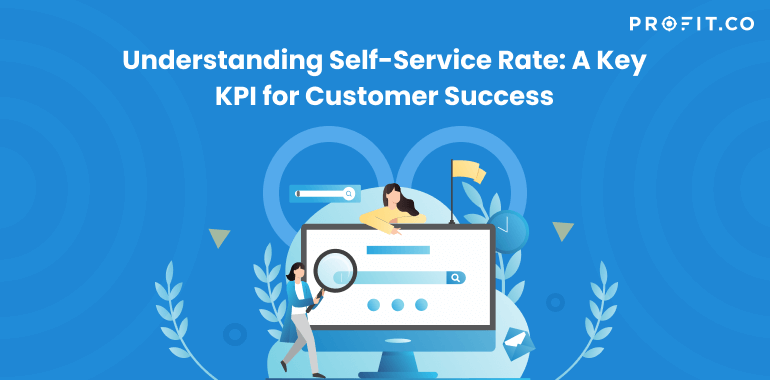Introduction
Studies show that 81% of customers attempt to care for matters themselves before contacting a service representative. In customer success, tracking and optimizing key performance indicators (KPIs) ensures customer satisfaction and business growth. One important KPI in this domain is the Self-Service Rate. It serves as a metric to measure the proportion of customer inquiries or problems successfully resolved through self-service channels, eliminating the need for direct intervention from customer support agents. By analyzing the Self-Service Rate, businesses can gauge how customers can independently access relevant information and resources, resulting in heightened customer satisfaction, decreased support expenses, and improved customer success.
In this blog post, we will delve into the concept of Self-Service Rate, its significance, and frequently asked questions, and provide an example of Objectives and Key Results (OKR) tied to this metric.
Successful businesses embrace self-service metrics as a means to empower customers and drive continuous improvement.
What is Self-Service Rate?
Self-Service Rate is a KPI that measures the percentage of customer inquiries or support requests resolved through self-service channels, such as knowledge bases, FAQs, and online documentation.
Why is Self-Service Rate Critical?
- Improved customer experience
Self-service options empower customers to find solutions to their problems quickly and independently, leading to higher satisfaction.
- Cost savings
By promoting self-service, businesses can reduce the load on customer support teams, resulting in cost savings.
- Scalability
Self-service resources can cater to many customers simultaneously, allowing businesses to scale their operations efficiently.
In short, the self-service rate is critical because it provides 24/7 availability, scales efficiently, enhances efficiency, and generates valuable data insights for continuous improvement.
Want to improve your business performance? Start measuring your KPIs now!
How is Self-Service Rate Calculated?
The self-Service Rate is calculated by dividing the number of self-service resolved inquiries by the total number of customer inquiries and multiplying by 100 to get the percentage.
Formula

Example
Let’s say a company received 500 customer inquiries over a specific period. Out of these inquiries, 350 were successfully resolved through self-service options.
In this case, the calculation would be:
Self-Service Rate = (350 / 500) x 100 = 70%
Therefore, the Self-Service Rate for this company would be 70%, indicating that 70% of customer inquiries were resolved through self-service options.
How Can I improve my Self-Service Rate?
To improve your Self-Service Rate, consider implementing the following strategies
- Ensure your self-service resources are comprehensive, up-to-date, and easily accessible.
- Promote self-service options through proactive communication with customers.
- Monitor user feedback and continuously improve self-service resources based on customer needs.
By implementing these strategies and tracking other customer success metrics like average satisfaction score you can enhance the accessibility, relevance, and effectiveness of your self-service resources, leading to an improved Self-Service Rate and greater customer satisfaction.
FAQs
1. What are some effective self-service channels?
Effective self-service channels include comprehensive knowledge bases, intuitive FAQs, community forums, interactive tutorials, and chatbots with intelligent responses.
2. Is a high Self-Service Rate always desirable?
While a high Self-Service Rate generally indicates successful customer enablement, it’s crucial to strike a balance. Some customers may prefer personalized assistance, so offering a mix of self-service and human support is essential.
OKR Example to Improve Self-Service Rate
Objective: Enhance customer satisfaction and optimize support costs
Key Result 1: Achieve a Self-Service Rate of 70% by the end of the quarter
Initiatives: Expand self-help resources with continuous monitoring and optimization through training.
Key Result 2: Reduce the average response time for self-service inquiries by 20%
Initiatives: Streamline self-service pathways and Improve the knowledge base.
Key Result 3: Increase customer satisfaction ratings related to self-service by 15%
Initiatives: Provide seamless escalation paths, interactive tutorials, and troubleshooting tutorials.
Besides the above OKR example, customer-obsessed organizations can easily manage their goals through the OKR platform to improve the self-service rate. Customer success OKRs can help with easy setting up and tracking the relevant metrics to achieve amazing customer success.
Conclusion
Continuous monitoring and analysis of self-service performance metrics, such as the Self-Service Rate, can provide valuable insights into customer behavior, identify areas for improvement, and guide optimization efforts. Regularly soliciting customer feedback and conducting user testing can uncover pain points or usability issues, allowing businesses to refine and enhance their self-service offerings.
In summary, a high Self-Service Rate indicates that businesses effectively empower their customers, reduce support costs, and scale operations efficiently. By tracking and optimizing this KPI, organizations can deliver amazing customer support, improve operational efficiency, and achieve sustainable business growth in today’s digital landscape.

